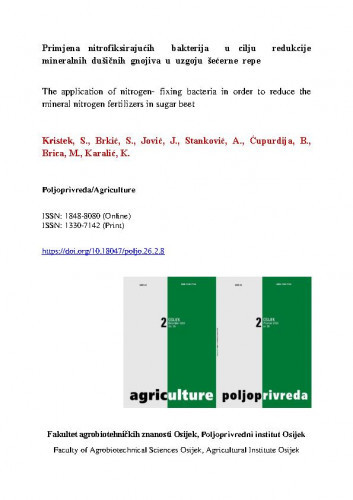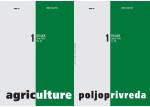Cilj je provedenoga istraživanja ispitati mogućnosti redukcije mineralnih dušičnih gnojiva primjenom slobodnih (Azotobacter chroococcum) i asocijativnih (Azospirillum brasilense) dušičnih bakterija u kulturi šećerne repe, uz zadržavanje visokih prinosa i kvalitete korijena. Uz povrće, najviše nitrata skupljaju vrste porodice Chenopodiaceae, kojoj pripada i šećerna repa. Dušik je prinosotvorni element, pa se u gnojidbi koristi u velikim količinama; međutim on je i najnestabilniji makroelement koji se ispire u dublje slojeve tla i vrlo često dolazi do eutrofikacije podzemnih voda. Brojne bolesti povezuju se s visokom količinom nitrata, nitrita i nitroznih spojeva podrijetlom iz hrane biljnoga izvora, vode i suhomesnatih proizvoda. Rezultati istraživanja pokazali su da je moguće reducirati mineralnu gnojidbu dušikom primjenom nitrofiksirajućih bakterija, dapače s dobivanjem veće kvalitete istraživanih svojstava šećerne repe. Nitrofiksirajuće bakterije nastanile su rizosferu korijena i biljke su se mogle koristiti raspoloživim dušikom koji im u danome vegetacijskom periodu treba, što nije slučaj kod gnojidbe dušičnim gnojivima.; The aim of this study was to examine the possibilities of reducing the mineral nitrogen fertilizers by applying the free‐living (Azotobacter chroococcum) and associative (Azospirillum brasilense) nitrifying bacteria in the sugar beet production, without a reduction in the yield and quality of the sugar beet root. Along with the vegetables, most nitrates are collected by the species of the family Chenopodiaceae, to which the sugar beet belongs. Nitrogen is one of the most vital elements in the achievement of high yields, so it is used in large quantities in fertilization. However, it is the most unstable macroelement that flushes into the deeper soil layers, and a groundwater eutrophication is caused very often. Numerous diseases are associated with the high amounts of nitrates, nitrites, and nitroso compounds, i.e., the nitrite and nitroso compounds originating from the foodstuffs having a plant origin, water, and the cured meat products. The results of the study have demonstrated that it is possible to reduce a mineral nitrogen fertilizer quantity by using the nitrogen‐fixing bacteria while even obtaining a higher quality of the studied parameters. The nitrogen‐fixing bacteria predominate in the rhizosphere, so the plants could use the amounts of nitrogen necessary in a given vegetation period, which is not the case upon a nitrogen fertilization.
Sažetak

 Poljoprivreda : 26,2(2020) / glavni i odgovorni urednik, editor-in-chief Manda Antunović.
Poljoprivreda : 26,2(2020) / glavni i odgovorni urednik, editor-in-chief Manda Antunović.